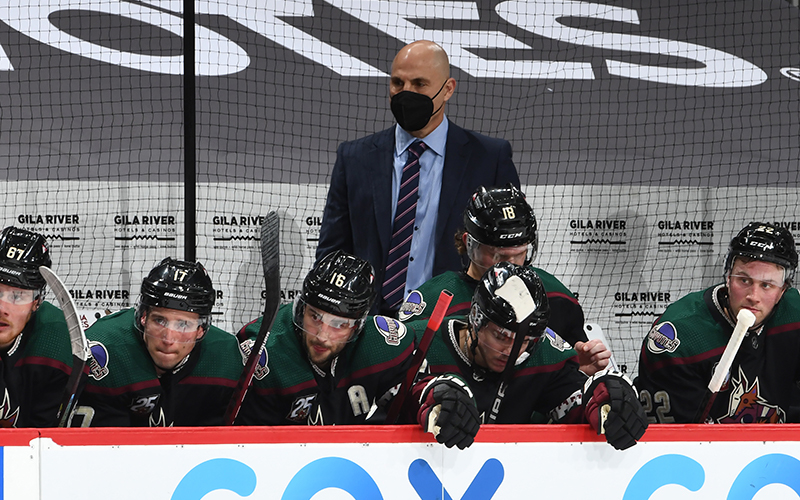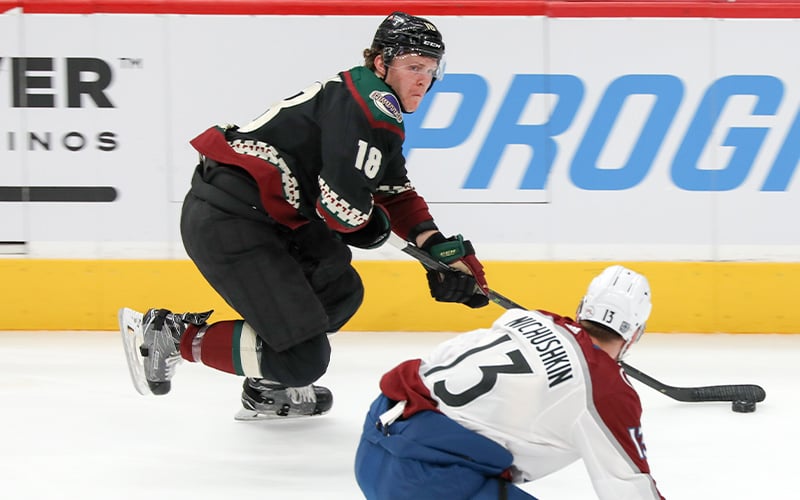
Coyotes coach Rick Tocchet looks on as Arizona prepares for the second half of the shortened season. Tocchet hopes his team can move past any “defeated” feelings. (Photo by Norm Hall/NHLI via Getty Images)
PHOENIX – The Arizona Coyotes arrived at the first half of the shortened 2020-21 season in the middle of the pack in the West Division.
After dropping two straight road games to the second place Minnesota Wild, the Coyotes sit five points out of the fourth playoff spot with a 12-12-4 record.
Coyotes coach Rick Tocchet brought up the troubles of his team’s mindset in the midst of a pivotal seven-game road trip.
“We’ve just got to make sure we don’t have guys feel like they’re defeated,” Tocchet said. “I know it’s the old adage, but you have to look in the mirror. I got to get these guys going in different ways in the big moments.
“We’re .500 now. There’s 28 games left. We can’t feel defeated. Yeah, we’ve got to score some goals, but we have to get some guys to play the right way. That’s the only way we’re going to get out of this.”
The Coyotes have hovered around the .500 mark for the majority of the first half, thanks to capitalizing in “big moments”, a phrase the coaching staff has been accustomed to conveying throughout the season.
Tocchet’s call for his veteran leaders to step up as key contributors has presented a mixed bag of results in the scoring and defending departments, pointing to the team’s overall record.
Unlike traditional years, there was no All-Star Weekend, giving teams an opportunity to regroup and recover at the midway point of each season. Nevertheless, Arizona will have to embrace 28 games over the next 54 days with limited time off and restrictions due to COVID-19 protocols.
Here are four takeaways from the Coyotes’ first half of the season:
Scoring slump
The Coyotes are in a scoring drought.
With two goals in their last three games, Arizona has fallen to 27th in the National Hockey League in goals per game at 2.43, a mark lower than last year’s playoff-clinching team (2.71).
“We’re definitely in a little bit of a rut here, offensively,” said forward Christian Dvorak, whose nine goals ties him for the team lead with forward Phil Kessel. “We’re not playing bad hockey, but in those key times, we’ve just need to find that goal.
“When you’re in a rut like this as a team, sometimes you just try to get too cute with it, which is not what we want to do. We just need to throw more pucks to the net.”
Dvorak is one of the many skaters snake-bitten on the scoresheet lately after red-hot starts.
After collecting 13 points in his first 12 games, Dvorak has collected just two helpers in his past ten games. Forward Nick Schmaltz registered 14 points in his first 16 games before tallying a goal and an assist in his last 12.
Kessel has lit the lamp in a streaky fashion. The veteran right winger scored his first goal in eight games in Sunday’s 4-1 loss to the Wild. He had four goals in his first four games of the year, then tailed off with no goals in the following 11.
Forward Derick Brassard has a goal and two assists in his last ten games. Forwards Lawson Crouse, Christian Fischer and Tyler Pitlick have generated little offensive production in their opportunities to take more responsibility in elevated roles.
Since the “Short Leash Line” lost its groove following the extended seven-game series with the St. Louis Blues, Tocchet has been throwing his line combinations into a blender with hopes of reigniting the offense.
“I don’t know if we have a line that can carry us through these slumps,” Tocchet said. “I think we have to use everybody, and that’s something we’re trying to find right now.”
Fifth-year forward Clayton Keller and third-year forward Conor Garland have been the consistent driving forces on offense. Keller, who is the highest-paid forward in his first year of an eight-year, $57.2 million deal, has 17 points in his last 18 games.
Garland leads the Coyotes with 14 assists and 22 points, which are on pace to set personal single-season highs. His tough-minded scoring presence has put a huge target on his back for the heavy hitters on opposing teams, which might explain Garland’s current dry spell, going four straight games without a point and just three shots on goal.
Coyotes general manager Bill Armstrong had an appropriate response in order to reactivate his top players’ scoring touches.
“You really have to defend your guys by going harder at their guys,” Armstrong said in a radio interview Monday with Jody Oehler on Fox Sports 910 Phoenix. “I think that’s the new world of the NHL in retrospect. I think we can do a better job of making sure we’re a harder team to play against in a lot of different facets, not only by playing clean, but harder against their stars. At the same time, we’ve got to find a way to defend ours a little bit better. Garland is a target, for sure. He is one of our better players. I think in the future we have to protect him.”
The Coyotes have noticeably struggled with getting pucks to the net. With 75 shots on goal through four games on the current road trip, Arizona now ranks last in the league with 25.4 shots on goal per game. Moreover, the Coyotes have allowed the seventh-most shots against per game at 31.6, further indicating a lack of puck possession in the offensive zone.
The players and coaching staff have pointed to this deficiency multiple times in their postgame press conferences. What’s the plan to create more scoring chances on a nightly basis? Going back to the basics.
“For us to put the puck in the net, it’s got to be a simple offense,” Armstrong said. “We can’t trade chances with teams. We can’t go up and down the ice. You’re going to lose against Minnesota. You’ll lose that way against Colorado. We’ve got to make sure it comes down to simple offense where we’re just getting back to the point and we put pucks and people to the net. It’s not that complicated when we’re at our best.”
Goaltending backbone
Whether the Coyotes are lighting up the lamp or not, the goaltending trio of Darcy Kuemper, Antti Raanta and Adin Hill have held down the fort at the other end of the ice.
For the past few years, the franchise has been known for its identity to fare better in low-scoring matchups with goaltending dominance at the forefront of their success.
The same can be said through the first half of this season with Arizona owning the sixth-best save percentage alongside the Montreal Canadiens and Los Angeles Kings at 91.4% and a 7-2-1 record when allowing two goals or fewer.
Kuemper, the team’s No. 1 netminder, has been rock solid this season with a 2.41 goals against average and .914 save percentage in 19 games, earning seven of the team’s 12 wins.
However, some heads were scratched when Kuemper awkwardly exited early in the third period during a 3-2 win over the Colorado Avalanche on March 8. The next day, Tocchet sent Kuemper back to Arizona for further evaluation on what has been deemed a week-to-week, lower-body injury.
Despite the setback, Tocchet trusts Raanta and Hill shouldering the workload in the crease.
“They’re going to hold the fort for us,” Tocchet said. “That’s what we expect them to do, and they have a track record of doing that for us.”
Through the seven periods since Kuemper’s injury, Raanta has made 91 saves on 96 shots while Hill stopped 28 of 31 shots in a 4-0 loss to Minnesota Friday.
Raanta, a former starter with the New York Rangers before a trade to the Coyotes in 2017, believes he can step up in Kuemper’s absence despite his own confidence concerns.
What. A. Save. ?
Antti Raanta is putting on a clinic against the Avs. #NHLonSN pic.twitter.com/wrzeCeoFZf
— Sportsnet (@Sportsnet) March 11, 2021
“I feel like sometimes I can be too critical of myself,” Raanta said. “The preparation was so much different coming into this year than normally. It has taken some time to get yourself adjusted to the schedule and … I really don’t want to make excuses. I need to be better and I know I can be better.”
It’s expected for Raanta and Hill to be the main tandem through March. The Coyotes called up Ivan Prosvetov from the Tucson Roadrunners of the American Hockey League to the taxi squad where he’ll serve as the third-string option between the pipes until Kuemper returns.
Defensive woes
There have been games where a lapse in focus on defense has translated to unsatisfying losses.
Sure, the Coyotes have shown their resilience in battling back from early deficits, but the routine of digging out of holes is an unsustainable winning formula, as shown during the current road trip.
Coyotes defenseman and captain Oliver Ekman-Larsson made the latest mistake, jumping up to make a hit in the neutral zone, which presented a clear path for Minnesota forward Nick Bonino to spring free and score the eventual game-winner in the third period.
BREAKAWAY BONINO!!!@mnwild | #mnwild pic.twitter.com/dMbJjQX54Z
— Bally Sports North (@BallySportsNOR) March 14, 2021
The defensive struggles have been heightened against the teams they’re chasing in the playoff hunt. In the second game of the series with the Avalanche, the Coyotes failed to clog a neutral zone pass that led to an odd-man rush and high-quality goal by Colorado forward Brandon Saad.
The @Avalanche didn’t waste any time scoring and have the 1-0 lead! ?@kylekeefetv and @RycroftMark have the first period highlights. #GoAvsGo pic.twitter.com/bh8BP99GKL
— AltitudeTV (@AltitudeTV) March 11, 2021
“One of our defensemen doubles up and they get a breakaway, they score,” Tocchet said. “They do something egregious and we don’t score. In big moments, we have a lot of guys struggling right now.”
All seven defensemen on the roster own a negative plus-minus rating with Ekman-Larsson and Jakob Chychrun, the team’s leaders on the blueline, holding a combined minus-17 rating.
Defenseman Alex Goligoski, who has played more minutes defensively as his offensive-minded partner Chychrun jumps up on rushes, addressed the team’s need to play tighter defense in transition for a more capable offense.
“We don’t have five guys getting on a forecheck the way they should to break up their breakout and they’re coming through the neutral zone too easy and then we’re wasting our energy defending,” Goligoski said. “We need everyone to be 200-foot players here. That’s what’s going to get us in the O-zone more and that’s what’s going to get us more looks and goals.”
Strength in schedule
When the Coyotes kick off the second half of their schedule today by closing out a three-game set against the Wild, they’ll begin the second easiest schedule remaining, according to the Power Rankings Guru.
Their second-half schedule features 11 home games and six sets of back-to-back games, but Arizona faces the Anaheim Ducks and San Jose Sharks, the bottom two teams in the division, a combined ten times.
The Coyotes have earned nine of the 12 possible points against Anaheim and San Jose while treading water with a 6-7-3 record against divisional heavyweights Vegas, Colorado and St. Louis.
Armstrong believes the upcoming stretch through March will determine whether the Coyotes find themselves at the trade deadline on April 12 as buyers or sellers.
“I think this month really will give us a good indication of where we’re at and where we’re coming down the stretch,” Armstrong said. “I think we have a favorable month of April, but we’ve got to find a way to make it through the month of March and still be in the hunt. I think that it will be clear after this month in what direction we are heading.”
For the moment, the Coyotes’ coaches and players look away from any postseason distractions and focus on what’s next right in front of them.
“We just have to take it one game at a time here,” Dvorak said. “We have to treat this next game as a huge game for us and bring the best effort we can.”
Added Goligoski: “We have to start rattling some wins off here and get ourselves up with those teams. The urgency should be really high.”

